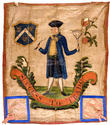 Although Govan was receiving increasing recognition by this period, it was not considered as important as Renfrew or Rutherglen. However, the village grew and, in addition to the new trades such as weaving and pottery there were, by the 16th century, extensive coal mine workings around Craigton and Drumoyne.
Although Govan was receiving increasing recognition by this period, it was not considered as important as Renfrew or Rutherglen. However, the village grew and, in addition to the new trades such as weaving and pottery there were, by the 16th century, extensive coal mine workings around Craigton and Drumoyne.
 With no proper police force until 1864, the Kirk fulfilled the role of director of the lives of Govan's citizens and custodian of their behaviour. While 17th and 18th century Session Records highlight the sometimes difficult task of maintaining law and order among the growing population, particularly in terms of intemperance, the church also showed its concern for the education of the youth of the Parish, not only in providing schools and qualified teachers, but also by enforcing school attendance.
With no proper police force until 1864, the Kirk fulfilled the role of director of the lives of Govan's citizens and custodian of their behaviour. While 17th and 18th century Session Records highlight the sometimes difficult task of maintaining law and order among the growing population, particularly in terms of intemperance, the church also showed its concern for the education of the youth of the Parish, not only in providing schools and qualified teachers, but also by enforcing school attendance.
 Its responsibilities included care of the sick and poor in what was a close knit community, certificates of character and of marriage being demanded of "incomers". The Govan Weavers Society, which was formed in 1756 with the charitable purpose of considering the welfare of the poor of the district, was instrumental in reviving the (Old) Govan Fair that same year. In 1757, Abraham Hill set up a Trust which led to the opening of Hill's Trust School in 1875. However, by far the most significant date in this period was 1759, when work began on deepening the River Clyde. There had been earlier attempts in 1556 and 1600 but this scheme paved the way for the establishment and growth of the shipbuilding industry during the 19th and 20th centuries.
Its responsibilities included care of the sick and poor in what was a close knit community, certificates of character and of marriage being demanded of "incomers". The Govan Weavers Society, which was formed in 1756 with the charitable purpose of considering the welfare of the poor of the district, was instrumental in reviving the (Old) Govan Fair that same year. In 1757, Abraham Hill set up a Trust which led to the opening of Hill's Trust School in 1875. However, by far the most significant date in this period was 1759, when work began on deepening the River Clyde. There had been earlier attempts in 1556 and 1600 but this scheme paved the way for the establishment and growth of the shipbuilding industry during the 19th and 20th centuries.